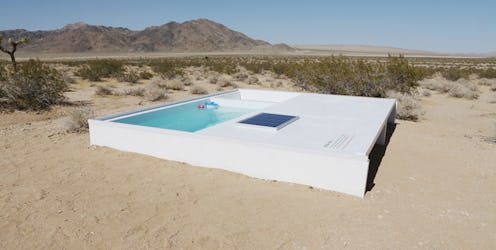News
Can You Find The Pool In The Middle Of The Desert?

How far would you go for luxury? That's the question that Austrian artist Alfredo Barsuglia is attempting to answer with his latest project, Social Pool, a high-end swimming pool in the Mojave Desert. The concept is simple: taking a piece normally associated with comfort and extravagance out of context, and making it deliberately difficult to reach forces the viewer to reevaluate the importance of luxury items. And we're talking very difficult to reach — the pool is literally in the middle of the desert.
It's a noble concept, but will the very nature of the project defeat its intentions? And do we need yet another art project in the middle of the desert?
Well, according to the project's official description:
Astutely intertwining the semantic constructs of contemporary art, the pool (the symbol of carefree wealth, even more so in the desert), relaxation and nature, Social Pool is a complex replica of the contradictions and ideology of contemporary society, where remoteness from others and quietude are luxuries for the ever-communicating city-dweller.
In other words, a pool behind a mansion or atop a high-rise is so blasé. But a pool in the desert? Now that's luxury.
"I wanted to build a man-made luxury that is in great contrast to the area around," Barsuglia told ABC News. "Water and pools are a status symbol, and it’s interesting to see how far people will drive to get to it." And far they must go indeed.
In order to view and interact with the installation, you need to literally hike through the desert. First you have to stop by the MAK Center For Art and Architecture in Los Angeles and pick up a key and GPS coordinates to the pool. After driving to the vicinity of the pool, you're required to park and hike to the exact location, which Barsuglia hid well on purpose. He advises against driving around and looking for it because it destroys the desert wildlife, and your car might get stuck in the sand.
What Barsuglia does advise, however, is bringing a gallon of water with you — for safety concerns, right? Because, well, you are literally hiking through the desert? Nope. The water is for replenishing the pool, which he recommends every visitor do, as part of the interactive nature of the project. That just makes me wonder: who's doing maintenance on this thing?
According to Gizmodo, the pool has a solar-powered filter and chlorination system built in, and there's even a pool boy on site to clean out tumbleweeds. Where is he stationed? How awkward would it be to finally stumble across the pool after hours of searching to find a pool guy just chilling nearby?
And what if Barsuglia did such a good job at making the pool hard to reach that very few people actually find the thing? If a conceptual art piece gets installed in the desert and nobody is there to see it, does it exist?
"When you are there by the pool," Barsuglia told the LA Times, "I think you really understand what a luxury this is and you start to ask yourself if it's really worth it. Perhaps some people might feel that this is not something they need to do." Can you really blame them?
Believe it or not, Social Pool isn't the first conceptual art piece of its kind.
Prada Marfa
In 2005, artist duo Elmgreen and Dragset installed a Prada store in the middle of the Texas desert near the town of Marfa. Named Prada Marfa, the permanent installation is a replica of a Prada store — the installation is in fact the only Prada store in the state of Texas — complete with handbags and shoes personally picked out by Miuccia Prada herself. Just a few days after its reveal, however, thieves broke in and stole the designer goods. But, really, what were they expecting?
Lucid Stead
Philip K. Smith III's Lucid Stead is a tribute to light, reflecting the desert surroundings in the daytime like a mirage and displaying colorful geometric shapes as the sun goes down. To someone unfamiliar with the art project, however, it's a dilapidated shack 20 minutes outside of Joshua Tree. Stead was commissioned to create a similar installation for this year's Coachella festival, a venue that perhaps makes far more sense.
Desert Breath
Now this is what I call an installation — or more accurately, land art. When incorporating art into the desert landscape, I say go big or go home. Created by D.A.ST. Arteam, Desert Breath is a large-scale spiral in the Saharan desert near the Red Sea coast, calling to mind iconic land artist Robert Smithson's Spiral Jetty. Completed in 1997, it is still visible on Google Earth almost two decades later.
Images: social-pool.com, Wikipedia, YouTube, Wikipedia